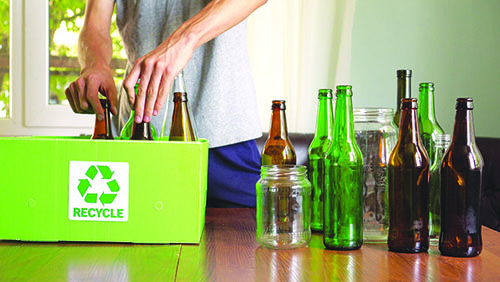by MAURA KELLER
A recent scrap metal recycling market research report, conducted by market research firm Technavio, indicated positive growth within the scrap metal industry in the short term as the business impact of COVID-19 spreads.

Specifically, as the markets recover, Technavio expects the scrap metal recycling market size to grow by 181.56 million MT during the period 2020 to 2024. And for 2020, the scrap metal recycling market is expected to post a year-over-year growth rate of 4.16 percent.
As the Technavio market report indicates, prices of nonferrous metals have been volatile, while the cost of ferrous metals is showing a steady upward trend. “With China regulating global steel production, global steel prices have increased. As a result, scrap metal recycling is growing in demand, aided by a strong demand-supply correlation,” the report stated.
One the primary drivers of the growth in the scrap metal industry is perceived to be the increased prices of raw materials. It is also contingent on the global markets recovery as we slowly emerge from the pandemic and COVID-19 vaccines become more readily distributed.
“The first phase of the pricing recovery was the recovery of the Chinese economy post COVID-19 which pushed prices higher and stabilized the market in early summer, which saw massive price depreciation in March to April,” said Babak Hafezi, chief executive officer of HafeziCapital International Consulting and Investment and Adjunct Professor of International Business at Kogod School of Business at the American University.
The second phase of the pricing recovery is based on the markets assessment that the Federal Reserve Bank will do everything possible to increase inflation and no longer be bound by its two percent target.
“In the August 2020 Federal Open Market Committee (FOMC) meeting, the Federal chair Jerome Powell called for a “flexible form of average inflation targeting” which federal officials called FAIT. This new strategy led to prices increasing in most commodities,” Hafezi said. “The Fed’s further liquidity policies and stimulus implications have driven the dollar lower. The third phase of the pricing recovery is global optimism for a global economic recovery based on the prospects of the various COVID-19 vaccines.”
Recently copper prices have done exceptionally well and have reached a seven year high, while steel rebar is also reaching 2018 highs. According to Hafezi, we see confidence in global markets as investments in iron ore mines are increasing, which is being driven primarily by China.
“China will be investing in two globally significant iron ore mines in the coming four years,” Hafezi said. “This shows confidence in future pricing and overall demand – both domestic and international.”
Michael Jenny, who has more than 15 years of experience in the scrap metal and recycling industry and is the managing director of investment banking firm Livingstone, said the current status of the scrap metal market is strengthening quickly. Jenny stated that anything commodity driven, particularly GDP growth related commodity metals – base metals, iron, ferrous, aluminum, copper – is driven by true end market demand increasing into 2021.
“A good example would be the building and construction markets; everyone is scrambling for materials; nobody thinks they have what they want, so they’re out there looking for more,” Jenny said. “Increased scrap pricing is the effect, and the cause is strong demand outstripping supply.”
The same can be said for stainless steel where lead times for domestic mills are growing.
As Jenny explained, customers of certain kinds of stainless recognize they need to buy forward in terms of expected price increases this year. Anecdotally, Jenny has heard OEMs are attempting to place orders forward for the next six to nine months.
“Now that’s on the prime grades, not the scrap, but it’s all directionally similar,” Jenny said. “2020 wasn’t as bad as expected or feared.”
COVID’s Impact on the Scrap Metals Market
COVID-19 hasn’t changed the scrap market materially. Fortunately, the scrap market isn’t like the movie theater industry or the restaurant industry; it is a materials industry. Scrap metal is essential, serving industrial, building, and construction end markets. Spending has remained strong in many of these end-markets. Indeed, the production of raw steel using ferrous scrap reduces the overall cost of production thanks in part to less mining of ore required and less energy being used in production.
“Overall, the industry has not been as adversely affected by COVID as feared,” Jenny said. “I think it’s the current driver of investor interest in the space and the supply and demand issues.”
However, Hafezi said that on a long term basis, the impact of COVID-19 on scrap markets may be extensive. Liquidity issues related to the rapid loss of demand in the early months of the pandemic will have a lasting effects on corporate balance sheets.
“Smaller players with weaker balance sheets got hurt more than companies that have ample access to debt and other forms of capital markets,” Hafezi said. “This is furthered by geopolitical pressures that COVID has had on relations. The continuation of the anti-China rhetoric from the U.S. expanded to countries such as Australia, that have a very close trading relationship with China. The Chinese response has been to limit trade with Australia, which has plunged the country into its first recession in nearly 30 years.”
Hafezi said we should also expect further consolidation in the coming years. As access to capital markets for larger firms becomes easier, smaller firms will have capital liquidity challenges in the coming years.
“As Chinese companies become even more powerful and consolidate their power, international players may need to further consolidate to be able to survive within the market,” Hafezi said.
Indeed, as Jenny pointed out, China will begin accepting ferrous scrap imports and there are supply disruptions in copper, which is expected to support copper pricing.
“However, I don’t see a real flashpoint. It is different for aluminum and copper than steel because they are widely and transparently traded on the global market,” Jenny said. “But ferrous is also driven by demand, and that demand can include domestic as well as export-driven, and we’ve seen the export demand increases.”
The Technavio market research report also indicates that factors such as large investments in infrastructural developments in South-East Asian countries such as Indonesia, Vietnam and Thailand will significantly drive scrap metal recycling market growth in this region over the forecast period.
“China, Japan, and India are the key markets for scrap metal recycling in APAC. Market growth in this region will be slower than the growth of the market in other regions,” the report stated.
The Future Outlook
Changes in the global economic outlook, or the poor implementation of the COVID-19 vaccines could cause major challenges to pricing power and lead to sharp pricing changes within the scrap metal market. Furthermore, Hafezi said any global sovereign debt defaults could trigger rapid changes in price, especially if they are driven by a commodity heavy country.
“Within the U.S. the removal of tariffs by the Biden administration which were imposed by the Trump administration will also lead to decreases in prices,” Hafezi said. “Based on current data we do not believe a Biden presidency will fully remove the trade issues with China, however its approach will shift drastically. Recycling industry professionals need to worry about leverage and the potential of a rapid devaluation of the U.S. dollar, which could also impact pricing of commodities. Any shifts in economic sentiment will have a rapid whip-lash effect on commodity pricing.”
Indeed the difference in mergers and acquisition activity between Labor Day 2020 and the present is a telltale sign that changes are happening that will impact the scrap metal industry. “In a span of a few months, we’ve gone from hearing crickets chirping to white-hot interest,” Jenny said. “Many investors view this moment as a good entry point in the commodity cycle. Strategics have cash and want to expand geographic reach. If owners are looking to recap, now is the time because markets are open, and everybody has cash.”
Published in the February 2021 Edition







